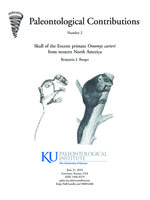The description of a skull of the omomyid primate Omomys carteri from the middle Eocene Bridger Formation of southwestern Wyoming provides important new information relevant to our understanding of Eocene primate systematics and evolution. More specifically, Omomys carteri exhibits a long and wide nasal region and lacks the forward orientation of the orbits found in other omomyid primates. Furthermore, other features such as an unreduced cranial arterial system, primitive auditory bulla, expanded internal choanae, and an unreduced canine indicate that the cranium of Omomys carteri is primitive. Phylogenetic analysis of 52 cranial, 194 dental, and 56 postcranial characters, including the new characteristics of Omomys carteri discussed here, suggests that omomyiforms belong to a monophyletic tarsiiform clade exclusive of anthropoids. Anthropoids are still viewed as a sister group to tarsiiforms, forming a haplorhine clade, with an uncertain position for the problematic fossil primate Rooneyia. The reconstructed cranial anatomy of the haplorhine morphotype is more primitive than originally thought and likely exhibited many of the primitive traits featured in the skull of Omomys carteri.
How to translate text using browser tools
21 June 2010
Skull of the Eocene Primate Omomys carteri from Western North America
Benjamin John Burger

Paleontological Contributions
Vol. 2010 • No. 2
Jun 2010
Vol. 2010 • No. 2
Jun 2010
Anatomy
Bridger Formation
haplorhine
mammal
omomyiform
tarsiiform




